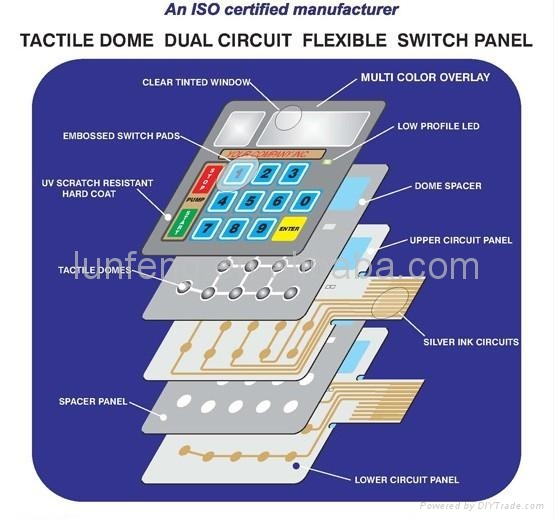How Membrane Switch Technology is Revolutionizing User Interfaces
Wiki Article
Comprehending Membrane Switches: The Secret to Reputable and sturdy Controls

What Are Membrane Switches?
Membrane switches are a sophisticated service in the world of interface innovation, integrating capability and design perfectly. These gadgets offer as a user interface in between customers and digital systems, incorporating several components into a compact format. Commonly constructed from adaptable, slim layers of materials, membrane layer buttons are created to react to touch, allowing customers to interact with machinery and digital gadgets efficiently.The main aspects of a membrane button consist of a printed circuit layer, graphic overlay, and a spacer layer that prevents unplanned activation. The visuals overlay can be personalized to reflect brand name identification or individual preferences, enhancing aesthetics while making sure functionality. Membrane layer buttons are generally utilized in different applications, including clinical gadgets, consumer electronic devices, and commercial tools, owing to their resilience and resistance to ecological factors such as dampness and dirt.
One of the essential advantages of membrane buttons is their ability to stand up to wear and tear, making them optimal for high-traffic atmospheres. Additionally, they are light-weight and call for very little area, permitting for cutting-edge styles in product advancement. Overall, membrane layer switches over stand for a sensible and reliable selection for contemporary electronic interfaces, weding innovation with user-centric layout principles.
How Membrane Layer Switches Job
The procedure of membrane layer switches over depend upon a straightforward yet efficient mechanism that equates individual input right into digital signals. These switches include multiple layers, generally consisting of a graphic overlay, a spacer layer, and a circuit layer. When an individual presses the switch, the top layer warps, enabling a conductive element in the circuit layer to reach a matching conductive pad on the underside of the graphic overlay. This call shuts the circuit and sends a digital signal to the tool, suggesting that the button has been triggered.The style of membrane buttons can vary, however they commonly incorporate domes or responsive components to offer comments to the individual, boosting the total experience - membrane switch. The materials utilized in membrane layer buttons, such as polyester or polycarbonate, add to their sturdiness and resistance to ecological elements, including wetness and dirt. The printed circuits are usually encapsulated, which secures them from wear and tear over time.
Benefits of Membrane Layer Buttons

In addition, membrane switches are known for their resilience. Built from durable products, they are resistant to dust, wetness, and physical wear, which substantially expands their lifespan compared to traditional mechanical buttons. This resilience makes them particularly ideal for high-traffic atmospheres and applications requiring durability.
One more considerable benefit is the ease of cleansing and maintenance. The smooth surface of membrane layer switches minimizes dirt accumulation and is commonly resistant to spills, making them excellent for setups that call for regular sanitization.
Furthermore, membrane buttons use a streamlined profile, bring about a thinner design that can be incorporated right into numerous tools without including bulk. This feature not only improves the visual appeal yet also adds to a more ergonomic product style.
Applications of Membrane Switches
Straightforward and flexible, membrane switches locate applications across a wide variety of markets, consisting of clinical tools, consumer electronics, More about the author and industrial equipment. In the medical field, these switches are indispensable to devices such as diagnostic tools, patient surveillance systems, and infusion pumps, where reliability and convenience of cleansing are critical. Their ability to keep and withstand harsh environments capability makes them optimal for such applications.
In customer electronic devices, membrane layer buttons are used in items like microwaves, washing makers, and push-button controls - membrane switch. Their streamlined layout permits user-friendly interface, improving the total customer experience while providing durability and resistance to wear and tear
Industrial tools additionally gains from membrane switches, particularly in control panels for machinery and automation systems. These switches use protection against dirt and dampness, ensuring constant performance in difficult settings. Furthermore, their adjustable functions enable suppliers to customize them to specific operational needs, enhancing effectiveness and performance.
Picking the Right Membrane Layer Switch Over
When picking a membrane layer button, it is crucial to take into consideration numerous variables that affect performance and suitability for certain applications. The main considerations include ecological conditions, responsive responses, longevity, and style requirements.
First, analyze the operating setting; buttons subjected to moisture, chemicals, or severe temperature levels need particular materials to make certain long life and performance. Next, review the demand for tactile feedback. Relying on individual interaction, some applications might profit from a tactile feedback to verify activation, while others may favor a non-tactile style for aesthetic factors.
Sturdiness is another critical aspect; membrane buttons ought to be designed to hold up against regular usage, effects, and abrasion. Ensure the chosen switch can withstand the expected lifecycle, specifically in high-usage situations.

Verdict
To conclude, membrane switches over work as vital components in the design of trustworthy and long lasting control systems throughout different industries. Their portable style, combined with durable construction and personalized functions, this article enhances individual interaction while making certain longevity sought after atmospheres. The versatility of membrane layer switches permits tailored options that meet details operational demands, reinforcing their value in contemporary innovation. As markets proceed to develop, the relevance of integrating reliable membrane button solutions can not be overemphasized.
Membrane switches represent a vital aspect of contemporary interface style, mixing capability with resilience in various applications.Membrane switches are an advanced service in the world of individual interface modern technology, incorporating capability and layout seamlessly. Generally built from versatile, thin layers of materials, membrane switches are designed to respond to touch, enabling individuals to communicate with machinery and electronic devices effectively.
The design of membrane buttons can differ, however they commonly integrate domes or tactile aspects to offer feedback to the user, boosting the total experience.In final thought, membrane switches serve as crucial parts in the style of long lasting and trustworthy control systems across numerous markets.
Report this wiki page